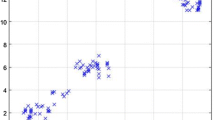Abstract
Different clustering algorithms are based on different similarity or distance measures (e.g. Euclidian distance, Minkowsky distance, Jackard coefficient, etc.). Jarvis-Patrick clustering method utilizes the number of the common neighbors of the k-nearest neighbors of objects to disclose the clusters. The main drawback of this algorithm is that its parameters determine a too crisp cutting criterion, hence it is difficult to determine a good parameter set. In this paper we give an extension of the similarity measure of the Jarvis-Patrick algorithm. This extension is carried out in the following two ways: (i) fuzzyfication of one of the parameters, and (ii) spreading of the scope of the other parameter. The suggested fuzzy similarity measure can be applied in various forms, in different clustering and visualization techniques (e.g. hierarchical clustering, MDS, VAT). In this paper we give some application examples to illustrate the efficiency of the use of the proposed fuzzy similarity measure in clustering. These examples show that the proposed fuzzy similarity measure based clustering techniques are able to detect clusters with different sizes, shapes and densities. It is also shown that the outliers are also detectable by the proposed measure.
Preview
Unable to display preview. Download preview PDF.
Similar content being viewed by others
References
Anders, K.H.: A Hierarchical Graph-Clustering Approach to find Groups of Objects. In: Proceedings 5th ICA Workshop on Progress in Automated Map Generalization, IGN, Paris, France (April 28–30, 2003)
Ankerst, M., Breunig, M.M., Kriegel, H.-P., Sander, J.: Optics: ordering points to identify the clustering structure. In: SIGMOD 1999. Proceedings of the 1999 ACM SIGMOD International Conference on Management of Data, pp. 49–60. ACM Press, New York (1999)
Bezdek, J.C., Hathaway, R.J.: VAT: A Tool for Visual Assessment of (Cluster) Tendency. In: Proc. IJCNN 2002, pp. 2225–2230. IEEE Press, Piscataway, N.J (2002)
Bicici, E., Yuret, D.: Locally Scaled Density Based Clustering. In: Roddick, J.F., Hornsby, K. (eds.) TSDM 2000. LNCS (LNAI), vol. 2007, Springer, Heidelberg (2001)
Doman, T.N., Cibulskis, J.M., Cibulskis, M.J., McCray, P.D., Spangler, D.P.: Algorithm5: A Technique for Fuzzy Similarity Clustering of Chemical Inventories. Journal of Chemical Information and Computer Sciences 36(6), 1195–1204 (1996)
Ester, M., Kriegel, H.-P., Sander, J., Xu, X.: A density-based algorithm for discovering clusters in large spatial databases with noise. In: KDD, pp. 226–231 (1996)
Guha, S., Rastogi, R., Shim, K.: ROCK: a robust clustering algorithm for categorical attributes. In: Proc. of the 15th Intl Conf. On Data Eng., pp. 512–521 (1999)
Huang, X., Lai, W.: Clustering graphs for visualization via node similarities. Journal of Visual Languages and Computing 17, 225–253 (2006)
Huband, J.M., Bezdek, J.C., Hathaway, R.J.: bigVAT: Visual assessment of cluster tendency for large data sets. Pattern Recognition 38(11), 1875–1886 (2005)
Jarvis, R.A., Patrick, E.A.: Clustering Using a Similarity Measure Based on Shared Near Neighbors. IEEE Transactions on Computers C22, 1025–1034 (1973)
Karypis, G., Han, E.-H., Kumar, V.: Chameleon: Hierarchical Clustering Using Dynamic Modeling. IEEE Computer 32(8), 68–75 (1999)
Zahn, C.T.: Graph-theoretical methods for detecting and describing gestalt clusters. IEEE Transaction on Computers C20, 68–86 (1971)
Yao, A.: On constructing minimum spanning trees in k-dimensional spaces and related problems. SIAM Journal on Computing, 721–736 (1982)
Author information
Authors and Affiliations
Editor information
Rights and permissions
Copyright information
© 2007 Springer-Verlag Berlin Heidelberg
About this paper
Cite this paper
Vathy-Fogarassy, A., Kiss, A., Abonyi, J. (2007). Improvement of Jarvis-Patrick Clustering Based on Fuzzy Similarity. In: Masulli, F., Mitra, S., Pasi, G. (eds) Applications of Fuzzy Sets Theory. WILF 2007. Lecture Notes in Computer Science(), vol 4578. Springer, Berlin, Heidelberg. https://doi.org/10.1007/978-3-540-73400-0_24
Download citation
DOI: https://doi.org/10.1007/978-3-540-73400-0_24
Publisher Name: Springer, Berlin, Heidelberg
Print ISBN: 978-3-540-73399-7
Online ISBN: 978-3-540-73400-0
eBook Packages: Computer ScienceComputer Science (R0)




